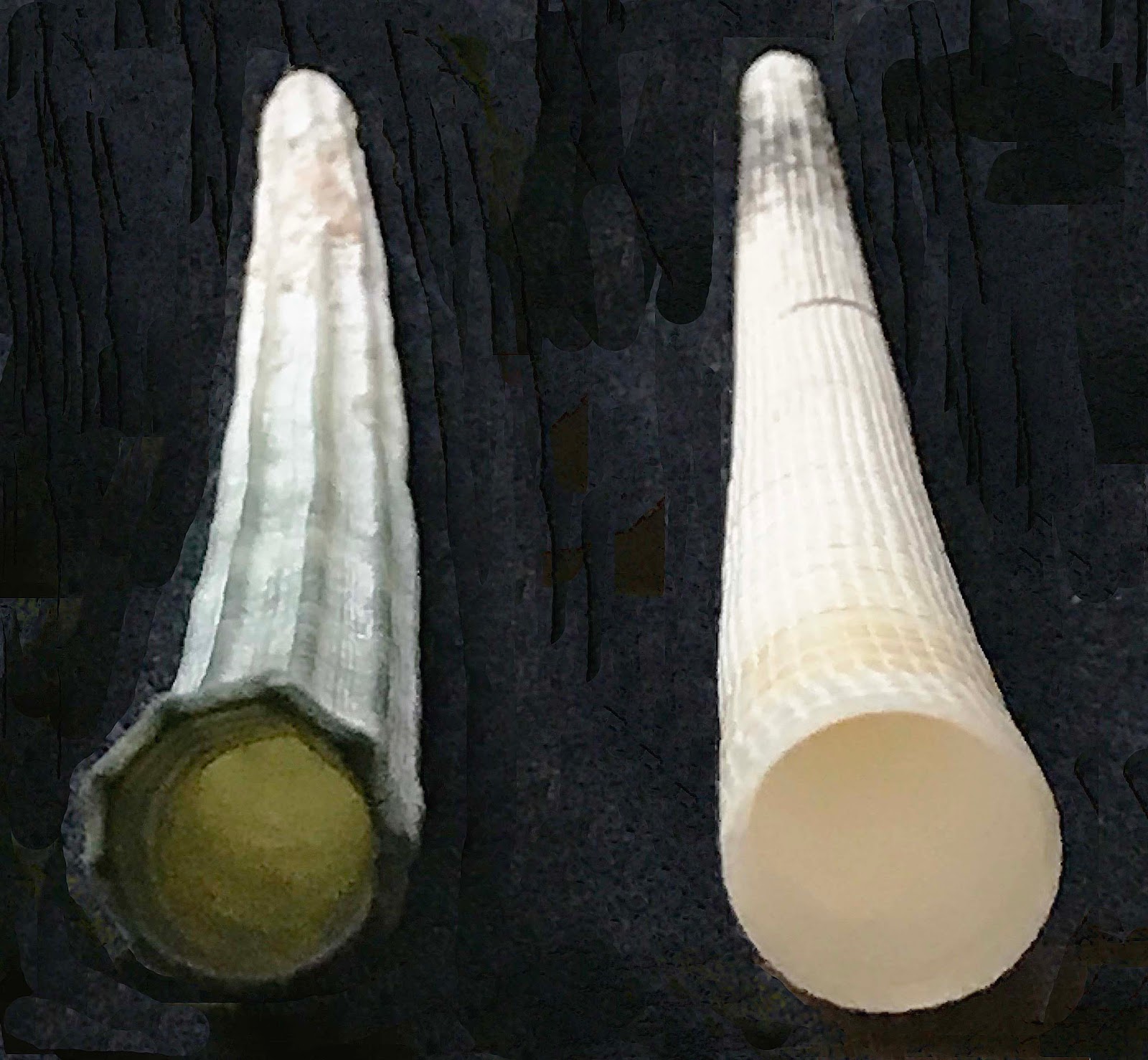The Money Clam
“Wapum,” a name derived from eastern North American indigenous people, was used for certain seashells used as money. As mentioned by Rohler (1971), for thousands of years, from Virginia to Canada, indigenous people in that region put small carved discs and tubes (with added central holes) of the commonly occurring Northern Quahog bivalve (clam) into strings of beads. This clam (a.k.a. the "money clam," which is found along the New England coast, has one of the hardest shells of any mollusk. These necklaces served as their money. The scientific name of this bivalve is Mercenaria mercenaria (Linné, 1758), and it belongs to family Veneridae. This bivalve lives in lagoons.
Top row: exterior views of the left and right valves of a specimen of the bivalve Mercenaria mercenaria (Linné, 1758); 60 mm (2.5 in.) wide, 50 mm (2 in.) high. Bottom row: interior views of the left and right valves of the same specimen.
A very similar looking bivalve is the Southern Quahog, Mercenaria campechiensis (Gmelin, 1791), which is common in inshore waters from Georgia, Florida, and northwestern Cuba. Additionally, a third very similar looking bivalve is Mercenaria mercenaria texana (Dall, 1902), which occurs commonly in shallow lagoons in the northern Gulf of Mexico. It seems very likely to me that these two additional bivalves could also have been used as “wampum.”
TWO EXAMPLES OF MONEY GASTROPODS (SNAILS)
1) Another shell used as wampum was the “channeled whelk” shell, Busycotypus canaliculatus (Linné, 1758), formerly known as Busycon canaliculatum (Linné, 1758). This large snail shell is made by the predatory neogastropod that belongs to family Buccinidae. Busycotypus canaliculatus lives along the New England coast, from Cape Cod, Massachusetts southward to Cocoa Beach, Brevard County, southeastern Florida.
Ventral and dorsal views of Busycotypus canaliculatus (length 19 cm, width 11.5 cm). Based on pl. 14, figs. 3, 4 of Hollister (1958).
2) The so-called "money cowrie" shell is the gastropod Monetaria moneta (Linné, 1758), which secretes small (commonly 1 inch in length) shells, pale yellow in color). They are widespread in rocky intertidal depths in tropical waters of the Indo-Pacific area and can be associated with coral-reefs flats. They are also found in the eastern Pacific Ocean (Galapagos Islands and Cocos Island off Central America).
Three views (base = apertural, dorsal, and right lateral) of the "money cowrie" Monetaria moneta, Indo-Pacific area, exact locality unknown, length 28 mm, width 20 mm, height 12 mm. The morphology of this species is quite variable (see figure below).
A small population (length 14 to 30 mm, width 10 to 21 mm) of Monetaria moneta showing considerable variation in color and shape.
The "money cowrie" was much more popular than the other “money shells” mentioned above because it is so widespread geographically. The use of "money-cowrie" shells dates back to antiquity (7th century AD) in India. They were also used in China in the 1300’s. When the Europeans reached these areas, the "money cowrie" became widely used. The Europeans also collected modern-day species of cowries from Africa and brought them to the Far East, where they used them for money, as well. As with other money shells, the money cowrie shells were also used for ornamental purposes.
The Money Scaphopod
Scaphopods (commonly known as “tusk shells”) are lenticular/hollow tubes secreted by mollusks belonging to an entirely different group of mollusks than either bivalves or gastropods. Scaphopods are found in shallow to moderately waters offshore where they partially burrow into soft sediment. Indigenous people of the Pacific Coast of North America used these shells as shell money, which was referred to as “haik-wa” or “hai-qua.” These shells were raked from the ocean floor. After being cleaned, the shells would be strung together into necklaces. Eventually, these kinds of shells were used by various tribes of the American West for ornamental purposes. In Alaska today, scaphopods are still used for ornamental purposes by remote tribes.
On the left: the "green" scaphopod: Dentalium elephantinum 11.5 cm long, 11 mm maximum diameter. On the right: a different species of Dentalium 12 cm long, 11.5 mm maximum diameter. Localities of both species unknown.
References Cited:
Hollister, S.C. 1958. Review of the genus Busycon and its allies. Part 1. Palaeontographica Americana v. 4, pp. 59~126.
Rohler, C. 1971. Shell Money. Of Sea and Shore, v. 2, no. 1, pp. 27–30.
[This journal is no longer being published by the editor Tom Rice (1939–2022), but the complete set is now online as a searchable archive containing all issues (1970–2004) and free downloadable pdfs. Go to: www.conchology.be










No comments:
Post a Comment